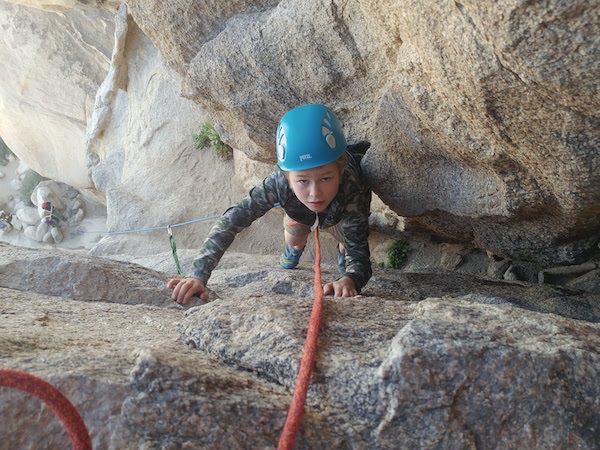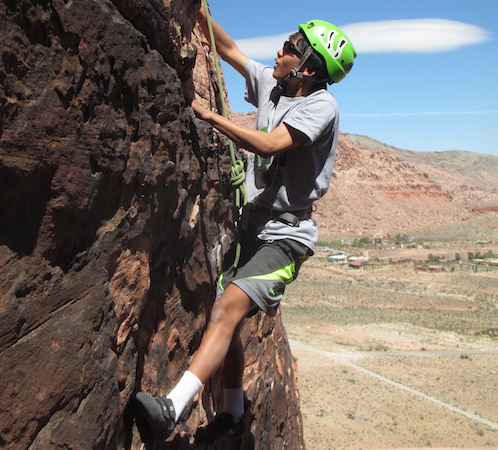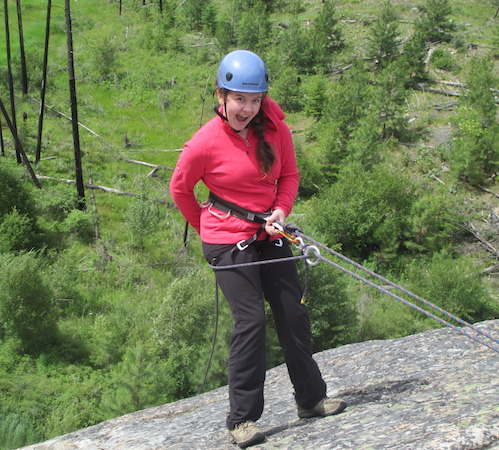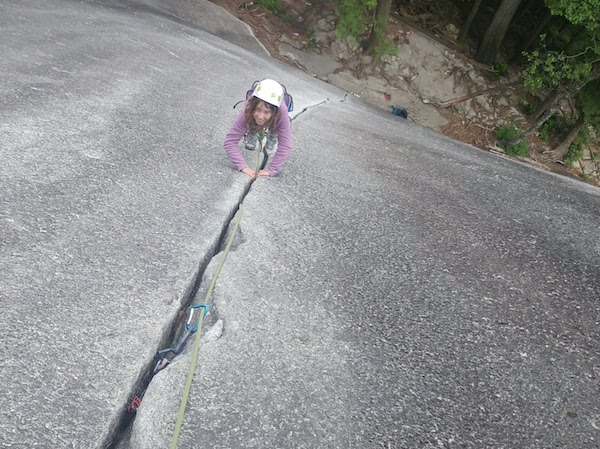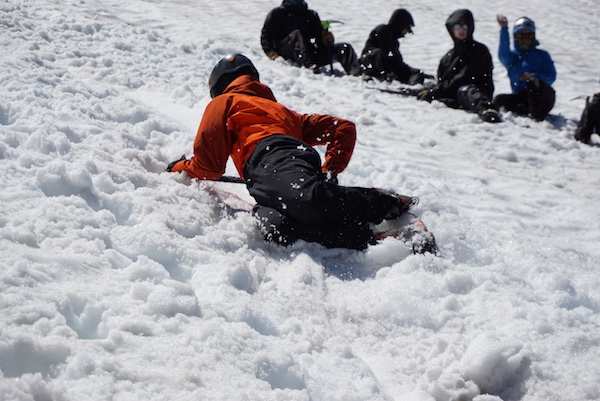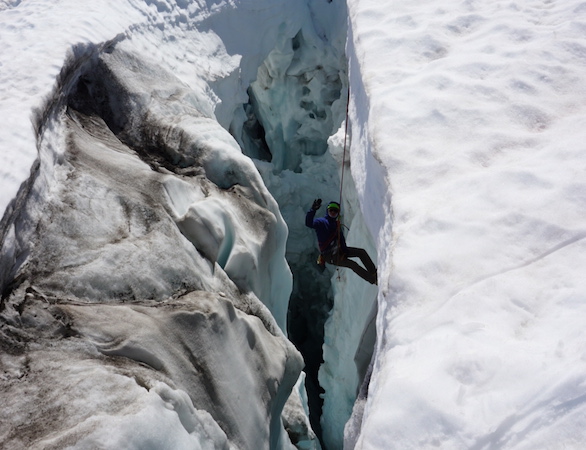Mountain Programs for Youth Organizations Overview Research shows that adventure education has an incredibly positive impact on children and youth. These types of experiences increase confidence, encourage cooperation, enhance communication skills, build self-reliance, strengthen friendships and instill a respect for nature and the environment.
A Girl Scout Climbing at Mt. Erie.
There are few things in this world that a young person will find more exhilarating than making their first rappel, skiing their first backcountry run, or swinging their first ice tool. Children and youth find mountain adventures to be challenging, invigorating and incredibly fun.
The American Alpine Institute has a long history of working with organizations to provide outdoor adventure experiences and education. AAI has the ability to build a custom program of any length for groups that would like to experience:
Rock Climbing
Bouldering
Ice Climbing
Mountaineering
Backpacking
Backcountry Skiing/Snowboarding
Avalanche Awareness Training
Leave No Trace Training
Programs may focus on a single type of adventure, or be combined with several different types of experiences.
Facilitated Youth Organizations
AAI defines facilitated youth organizations as organized groups that book a program as a single unit. These include, but are not limited to, Boy Scouts, Girl Scouts, summer camps, schools, universities, youth groups and church programs. AAI also has the ability to subcontract for other types of youth programs like, mountain schools, private outdoor education institutions, and adjudicated youth programs.
The staff at AAI strongly believes in getting kids and young people outside. And we will work to find a way to provide training, education and experiences within your budget.
Teenage climbers make their way across the summit plateau of Mt. Baker. Jacky Thompson
Mountain Programs for Youth Organizations Pricing Considerations There are a handful of things that an organizer should consider before booking instructors from the American Alpine Institute. These include the location of the program, program ratios, food and lodging, rentals, and transportation. Following is an in-depth break-down of each of these things.
Location
A student receives instruction during a rappel in Leavenworth, WA.
The American Alpine Institute operates in seven states and in sixteen countries. Following is a breakdown of areas that AAI regularly operates in within the United States and what can be provided in those locations.
Foreign programs have not been included in this list. If you have an interest in foreign programming with AAI, contact us.
Alaska (Talkeetna) - Mountaineering, Leave No TraceWashington (Bellingham) - Mountaineering, Rock Climbing, Bouldering, Ice Climbing, Backcountry Skiing, Avalanche Awareness, Backpacking, Leave No TraceCalifornia (Mammoth Lakes/Bishop) - Mountaineering, Rock Climbing, Bouldering, Ice Climbing, Backpacking, Leave No TraceCalifornia (Joshua Tree) - Rock Climbing, Bouldering, Leave No TraceNevada (Las Vegas) - Rock Climbing, Bouldering, Leave No TraceUtah (Moab) - Rock Climbing, Bouldering, Leave No TraceColorado (Boulder/Estes Park) - Rock Climbing, Bouldering, Ice Climbing, Mountaineering, Backcountry SkiingColorado (Ouray) - Ice ClimbingNorth Carolina ( Brevard) - Rock Climbing
Please note that instructors are not available in every venue, every month of the year.
Ratios
Prices are generally based on the ratio. In other words, the more people per instructor, the lower the price.
In a single-pitch rock climbing setting, an instructor can handle up to six people at one time. It is possible to have more people per instructor in this kind of setting, but the additional students will have to wait and watch.
In a multi-pitch rock climbing setting, it is preferable to have a 2:1 student to instructor ratio. There are some short alpine rock climbs, where it is acceptable to have a 3:1 ratio.
Ice climbing has the same ratio considerations as rock climbing.
Avalanche awareness courses may have up to a 6:1 ratio. Backpacking and Leave No Trace may have up to a 10:1 ratio.
Ratios for mountaineering and backcountry skiing are determined by the objective. Most commonly they have 4:1 ratios.
Food and Lodging
On multi-day programs, AAI can provide food and lodging for additional fees.
Backcountry food is provided at $25 per person per day. However, an organization may choose to prepare their own food to avoid this fee.
AAI will take care of backcountry camping fees and reservations. We can also provide front-country camping options or hotel reservations if needed. The price for these services varies based on the area and the need.
Rentals
A student hangs in a crevasse while his teammates participate in a crevasse rescue drill.
Rental fees vary by need. AAI has a robust inventory of rental equipment for the different activities listed within this program page.
Facilitated groups should work with the program coordinator prior to their trip to ensure that each participant will have the rentals that he or she needs.
Transportation
AAI has access to several large vans in Washington State, and one smaller vehicle in Las Vegas. These may be used to help transport students to and from program locations for an additional fee.
If an organization chooses not to employ AAI's transportation options, the organization will be responsible for transporting the instructor to the program area. Commonly, private programs will simply pick up the instructor on the way to the program area. If you do not have room in your vehicles, it is also possible to pay for the instructor's mileage to and from the area.
Mountain Programs for Youth Organizations Risk Management The American Alpine Institute understands orginizational risk management concerns and will work with an organization to address those. Following are some of the things that AAI does to ensure that these concerns are addressed.
Student Safety
Is this program safe?
Canadian Girl Guides learning knots.
p>This is a common question made by those managing youth organizations. The answer is that, no, it is not completely safe. There are inherent risks in climbing, skiing, mountaineering, backpacking and in backcountry travel. Though it's rare, it is entirely possible for someone to get hurt participating in these activities. AAI instructors employ best practices and are highly trained in the disciplines in which they work. But that does not eliminate all risk.
Part of the value of adventure education is that there is an element of risk. This element is crucial to personal growth. The only way to mitigate all risk in the mountains, is to avoid the mountains all together. We believe that avoidance insulates young people. And that the process of managing risk in the mountains provides an education in managing risk throughout one's life.
Risk Management Plans
A risk managment plan is a written document that identifies the hazards associated with an activity in a given location. The plan provides strategies to mitigate hazards, while also identifying a plan of action in the event of an emergency. AAI has a risk management plan in place for each area of operaton. A plan for a given area and activity may be provided to an organization upon request.
Following are some key topics addressed in AAI's risk managment plans:
Employee Hiring and Training Information
Employee Background Checks
Emergency Response Plan
Safety Briefings
Operational Safety for Vehicles
Best Practices for Instruction and Guiding
Personal Protective Equipment Use and Retirement Policies
Communications (Standard and Emergency)
Youth Protection Training Strategies
Crisis Response Plan
If an orginization requires something specific within a risk management plan, AAI can customize the content to meet your needs.
Additional Insured
Many organizations require a certificate that states that they are insured under AAI's umbrella. Institute coordinators can accomodate this as long as an organization provides a minimum of two weeks notice that such a certificate is required.
Release Forms / Waivers
AAI requires minors to have a form signed by a parent and sent in, prior to the start of a program. To see a sample release form, click on the download to the right.
Mountain Programs for Youth Organizations Popular Programing Options The breadth of AAI's programming is vast. But there are a few programs that tend to be popular with youth organizations. Each of the following programs has been run several times with diverse groups of tweens, teens and young adults.
Red Rock Canyon Rock Climbing (Las Vegas, NV)
Rock climbing in Red Rock Canyon.
Red Rock Canyon is located 19-miles from the Las Vegas Strip and it is considered to be a world-class climbing destination. It has a little bit of everything. It has bouldering, single-pitch crags and multi-pitch adventures.
Climbing in Red Rock (or Red Rocks as many call it) is best October through April. In the summer it's too hot to adequately climb. But in the Fall, Winter and Spring seasons, the area provides pleasant climbing in the sun.
Obviously, there are thousands of hotel rooms in Las Vegas. But there is also a campground near the Conservation Area, with both single and group sites available. All sites may be reserved ahead of time.
Mt. Erie Rock Climbing (Anacortes, WA)
Mt. Erie is a cool little peak, nestled close to the ocean. The views from this climbing area are outstanding, with the San Juan Islands on one side and the Cascade Mountains on the other, it is a place not to be missed.
Anacortes is a small city about an hour-and-a-half north of Seattle. There are several campsites in the area, both in Anacortes and near Mt. Erie. However, reservations need to be made early as it is a busy place in the summer.
Mt. Erie is primarily a single-pitch rock climbing place. It is an excellent venue for young people to have their first experience on the rocks.
The season at Mt. Erie is April through September. During the winter, it can be wet.
Mt. Baker Skills and Climb (Bellingham, WA)
Mt. Baker is a 10,781-foot volcano perched on the northern edge of Washington State in the Cascades. The peak has several possible routes that range in difficulty from moderate to very advanced.
Students who wish to climb Mt. Baker should have a good level of endurance and should train hard for the mountain. Younger climbers (13-15 year olds) will need four-days on the mountain. Older climbers (16-Adult) who are fit will commonly do it in three days.
The four-day recommended Mt. Baker itinerary is as follows:
Day One:
A teenage group celebrates on the summit of Mt. Baker. Dawn Glanc
Meet at the AAI headquarters in Bellingham at 7am. Complete a gear check and obtain rentals. The instructors will help students pack their packs so that they are as light as possible. This process will take two to three hours.
Once the gear check is complete, we will drive for 1.5 hours to the trailhead at 3,670-feet. From there, we will hike approximately 3.5 miles to a camp at 6000-feet.
If there is time in the afternoon, the team will work on some basic ropework, snow and glacier travel skills.
Day Two:
On the second day of the program, the focus will be on skills. The team will learn ice axe and crampon skills, as well as rope and glacier travel skills.
The team will finish early because the next day will start very early.
Day Three:
This is summit day!
The team will get up between 1am and 4am, depending on the weather and the instructor's summit strategies. They will then leave camp to climb the Coleman-Deming Route.
The Coleman-Deming requires students to climb around crevasses on glaciated terrain. The final 1000-feet is on 40-degree terrain. Once this section is completed, students will trek across the summit plateau to the true summit at 10,781-feet.
It will take most student parties between eight and twelve hours to reach the summit. And it will take another four to six hours to get back to camp.
Day Four:
The team will get up leisurely, tear down camp and hike out.
On the three-day program, the team will summit and hike out on the same day.
The Roosevelt and Coleman Glaciers converge below Mount Baker's North side as seen from the approach trail. Our camp is at the snowline. AAI Collection
Mountain Programs for Youth Organizations Related Courses
Program Finder
By Location
United States - Alaska
United States - Washington
United States - California
United States - Nevada
United States - Colorado
United States - Utah
Canada - British Columbia
South America - Argentina
South America - Bolivia
South America - Ecuador
South America - Patagonia
South America - Peru
Europe - Alps and Caucasus
Asia - Nepal and Tibet
Asia - Laos, Thailand, & Vietnam
Asia - China
Asia - Japan
Africa - Tanzania
Pacific and Antarctica
By Program Type
Instructional Courses
Group Summit Climbs
Expeditions
Skills Expeditions
Private Guided Programs
Treks, Tours, & Backpacking
Corporate Outings & Services
Government & Military
By Activity
Rock Climbing
Ice Climbing
Alpine Climbing
High-Altitude Climbing
Trekking and Backpacking
Skiing & Snowboarding
Guide Training & Rescue
Avalanche Training
Departure Month
Difficulty Level
Beginner
Moderate
Intermediate
Advanced
Very Advanced
x
